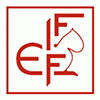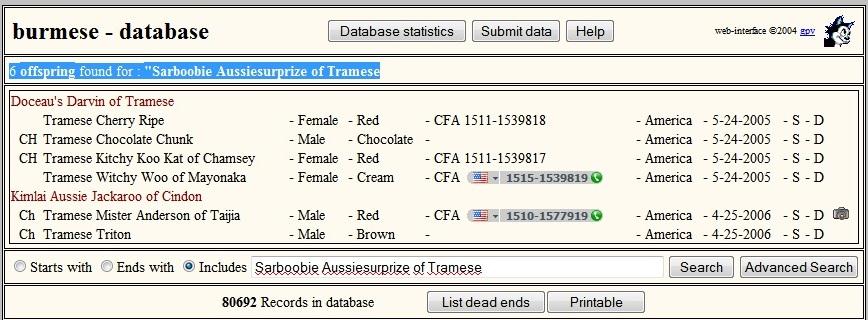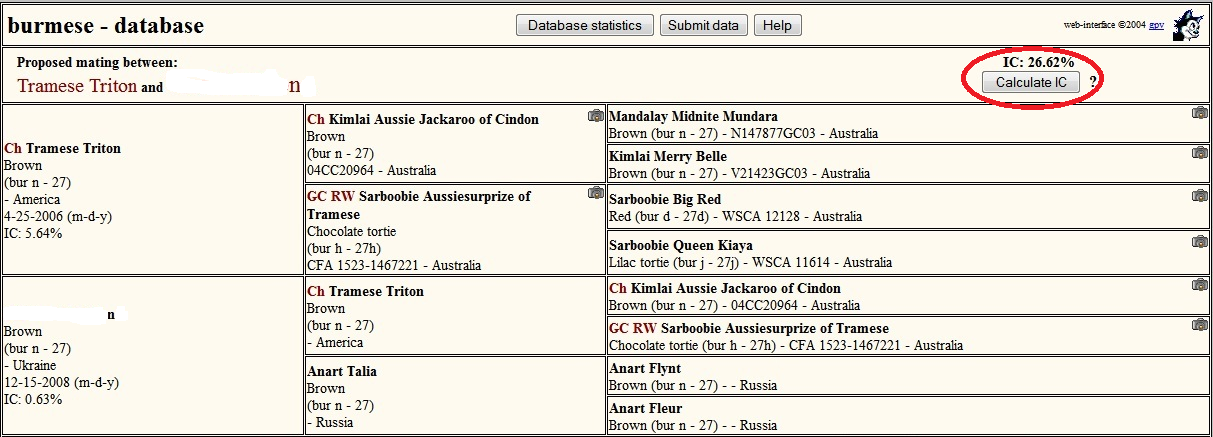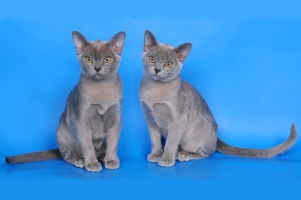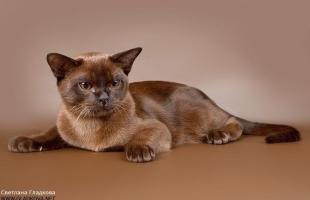Instruction on using the database of the Burmese family trees
I represent to your attention the instruction on using the database of the Burmese family trees.
Here is its address in the Internet: www.burmesepedigrees.com
The family trees of about 74 000 of Burmese cats are presented in the base.
The system allows to find the following information:
1. A family tree
2. In-breeding factor
3. The genetic statistics
4. The data on ancestors, posterity, brothers, sisters
5. To make a family tree of the future kitten
Certainly, the information set above can be received in case the Data on the animal is in the base.
Before addressing the database, I suggest to pay attention to all components of the main page.
- At a clique on word Burmese we get to the Burmese family trees base (We will discuss it a bit later).
Below, in the middle of the field the letters in alphabetic order are located.
At a clique on these letters we get to the list of the Burmese names, whose Family trees lack in the base.
Composers ask those who has the necessary information, to help in Base filling and to send the data on the specified e-mail address, or to fill the electronic form: Cliques on Burmese then on Submit data and fulfill the form:
At a clique on the button Burmese we get directly to the searching base. In the search line we enter the original name of the animal:
If you don't know its full form, it is possible to enter a part of the name, preliminary having put a dot in the parameter Includes (includes). For example, we write a name part:
Triton and press the button Search:
We see the following picture:
We recognize Triton by its full name and click on it. We get on its family tree page.
Pay attention that opposite to some names there is a camera icon. It means that the given animal has photo in the base. We click on one of the names with camera icon and see the photo of the animal in the right top corner:
So, in the top left corner of the page of a family tree we see some data about the cat:
- A title and a name
- A gender (Male), color (Brown) and in brackets is a breed, color symbol, and a color code
- The country in which the cat has been born
- The date of its birth and age at present
- In-breeding factor
Above there is a button Database statistics
Having pressed on Database statistics we get to the Burmese breed database that reflects the statistics on several parameters: 
1st column – Parents.
Here is the information on the general number of animals presented, in whose family trees there is an information on both parents – 93,4 %, animals whose family trees contain info only about the father – 0,2 %, info only about the mother, and further, following the list.
2nd column - Colors
Here the representative data on all Burmese colors brought to the given base is presented. From the table it is obvious that the brown color is in the lead, further follows blue, then chocolate, etc.
Brown: - 25 %
Blue: - 11.5 %
Chocolate: - 10.4 %
3rd column – the Countries in which animals have been born
We see that England is in the lead, then America, and on the third place is New Zealand.
England: - 36.5 %
America: - 26.5 %
New-Zealand: - 10.2 %
The button Submit data we discussed earlier.
Button Help contains various helps; I will not stop in detail on it, since all helps are presented in this book.
We move further.
In the top left corner there are buttons, each of which is a guide to the information:
Pressing the button Calculate IC we get to the genetic statistics (Genetic statistics), where the following data is presented:
- In-breeding factor (IC) in a cat’s family tree (Inbreeding coefficient: 5.64 %)
- The general ancestors of the cat, with in-breeding factor > 2 % (Common ancestors with a significant (> 2 %) part in the IC)
Thus we see that 29 % from the general inbreeding factor (5,64 %) are on the animal - Riokay Illusion
We come back to the Triton’s family tree page.
The top left button is 8 Offspring
The button 8 Offspring opens the information on Triton’s posterity.
Having clicked on this button, we see the table with the names of the females who were matching Triton and the children, born from these copulations.
We come back to the family tree.
Button Find ancestor will show Triton’s ancestors.
To find the necessary ancestor, type in the bottom search line of the family tree a name part, either a full name, or the name of the cattery in which you would like to find the Triton’s ancestors. Well, for example the cattery Tramese. We enter the name of this cattery into the searching line.
And press the button Find ancestor or the button Search opposite the entered name of the cattery.
The base will show all Triton’s ancestors carrying a prefix of the cattery Tramese.
Again we come back to the family tree page.
Button Sire siblings will show us Triton’s brothers and sisters on one parent – on the father’s side.
Clique on Sire siblings and see that Triton has 3 brothers on father’s side - 3 offspring found for : «Kimlai Aussie Jackaroo of Cindon»
Button Dam sibling will show us the Triton’s brothers and sisters on one of the parents – on the mother’s side.
Братья и сестры Тритона по его матери
6 offspring found for: « Sarboobie Aussiesurprize of Tramese»
Button Full sibling will show us Triton’s brothers and sisters on the father’s and mother’s side, i.e. children having same father and mother, as Triton does.
Button Reverse ped leads us to the information about Triton’s posterity. By pressing, the base gives out all children of the cat (if they are in the base).
Button Planned mating allows us to see the future family tree of the kittens born from the copulations of the male with the certain female which family tree, certainly, is in the base.
For this purpose it is necessary, being on Triton’s family tree page, to bring a name of the female – N in a search line in the bottom of the family tree.
Then press the button Planned mating in the top right corner of the family tree.
In the appeared window, we will see an interactive line with a name of the female (with which we plan the copulation). We click the female’s name N and we get on a family tree of the kitten from the copulation of Triton with the female N. And the name of the kitten will be pointed as Tramese Triton and N
We have a possibility to look at the inbreeding factor of the future kitten. For this purpose it is necessary to press simply the button Calculate IC and there will be an inbreeding factor from above.
Good luck!
(c) Anastasiya Voropaeva
Programming - Webstudio73.com



